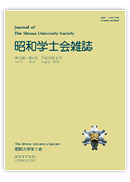Volume 73, Issue 3
Feature Articles: Prefatory Note for Special Issue of Cytomegalovirus
Displaying 1-13 of 13 articles from this issue
- |<
- <
- 1
- >
- >|
Feature Articles: Prefatory Note for Special Issue of Cytomegalovirus
-
2013 Volume 73 Issue 3 Pages 137-138
Published: 2013
Released on J-STAGE: June 23, 2014
Download PDF (237K) -
2013 Volume 73 Issue 3 Pages 139-144
Published: 2013
Released on J-STAGE: June 23, 2014
Download PDF (339K) -
2013 Volume 73 Issue 3 Pages 145-147
Published: 2013
Released on J-STAGE: June 23, 2014
Download PDF (218K) -
2013 Volume 73 Issue 3 Pages 148-153
Published: 2013
Released on J-STAGE: June 23, 2014
Download PDF (431K) -
2013 Volume 73 Issue 3 Pages 154-162
Published: 2013
Released on J-STAGE: June 23, 2014
Download PDF (1031K) -
2013 Volume 73 Issue 3 Pages 163-170
Published: 2013
Released on J-STAGE: June 23, 2014
Download PDF (373K)
Invited Review
-
2013 Volume 73 Issue 3 Pages 171-178
Published: 2013
Released on J-STAGE: June 23, 2014
Download PDF (1986K)
Final Lecture
-
2013 Volume 73 Issue 3 Pages 179-189
Published: 2013
Released on J-STAGE: June 23, 2014
Download PDF (2167K)
Educational Lecture
-
2013 Volume 73 Issue 3 Pages 190-195
Published: 2013
Released on J-STAGE: June 23, 2014
Download PDF (700K)
Original
-
2013 Volume 73 Issue 3 Pages 196-202
Published: 2013
Released on J-STAGE: June 23, 2014
Download PDF (431K) -
2013 Volume 73 Issue 3 Pages 203-215
Published: 2013
Released on J-STAGE: June 23, 2014
Download PDF (405K) -
2013 Volume 73 Issue 3 Pages 216-223
Published: 2013
Released on J-STAGE: June 23, 2014
Download PDF (927K) -
2013 Volume 73 Issue 3 Pages 224-231
Published: 2013
Released on J-STAGE: June 23, 2014
Download PDF (363K)
- |<
- <
- 1
- >
- >|
